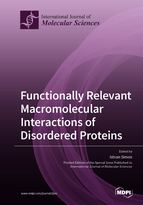Functionally Relevant Macromolecular Interactions of Disordered Proteins
A special issue of International Journal of Molecular Sciences (ISSN 1422-0067). This special issue belongs to the section "Molecular Biophysics".
Deadline for manuscript submissions: closed (30 September 2018) | Viewed by 84104
Special Issue Editor
2. Center of Excellence of the Hungarian Academy of Sciences, 1117 Budapest, Hungary
Interests: protein structures; protein dynamics; protein conformation; protein folding; protein bioinformatics; protein interactions; membrane proteins; protein stability; intrinsically disordered proteins; protein biophysics; protein binding; molecular biophysics; protein refolding; membrane transport proteins; computational structural biology; structural bioinformatics
Special Issues, Collections and Topics in MDPI journals
Special Issue Information
Dear Colleagues,
It is common that most proteins function in folded form. Another significant portion of proteins or protein segments spend a part- or sometimes most- of their time in an unstructured/disordered form. They generally fold only temporarily-typically on the surface of another protein or other macromolecule during their biochemical activity. This phenomenon has been widely studied in the past decade. However, we are expecting a great deal of new information about the functional relevance of this coupled folding and binding for this issue of IJMS. Up-to-date databases like IDEAL and DisProt are listing unstructured proteins, while ELM and DisBind are listing binding segments of this protein. A new database, Schad E et al. "DIBS: a repository of disordered binding sites mediated interactions with ordered proteins" has recently been made available in Bioinformatics: https://doi.org/10.1093/bioinformatics/btx640. A smaller but not negligible portion of disordered proteins fold via interaction with one or more disordered protein molecules. During this joint folding process, there is no template to use- the two or more polypeptide chains have to fold jointly by themselves. Since few attempts have been reported in the literature on these kinds of complexes, I kindly call your attention that the first such database Ficho E et al. "MFIB: a repository of protein complexes with mutual folding induced by binding" recently became available in Bioinformatics: https://doi.org/10.1093/bioinformatics/btx486
Prof. Dr. Istvan Simon
Guest Editor
Manuscript Submission Information
Manuscripts should be submitted online at www.mdpi.com by registering and logging in to this website. Once you are registered, click here to go to the submission form. Manuscripts can be submitted until the deadline. All submissions that pass pre-check are peer-reviewed. Accepted papers will be published continuously in the journal (as soon as accepted) and will be listed together on the special issue website. Research articles, review articles as well as short communications are invited. For planned papers, a title and short abstract (about 100 words) can be sent to the Editorial Office for announcement on this website.
Submitted manuscripts should not have been published previously, nor be under consideration for publication elsewhere (except conference proceedings papers). All manuscripts are thoroughly refereed through a single-blind peer-review process. A guide for authors and other relevant information for submission of manuscripts is available on the Instructions for Authors page. International Journal of Molecular Sciences is an international peer-reviewed open access semimonthly journal published by MDPI.
Please visit the Instructions for Authors page before submitting a manuscript. There is an Article Processing Charge (APC) for publication in this open access journal. For details about the APC please see here. Submitted papers should be well formatted and use good English. Authors may use MDPI's English editing service prior to publication or during author revisions.
Keywords
- disordered protein
- unstructured protein
- coupled folding and binding
- mutual folding
- protein complex







